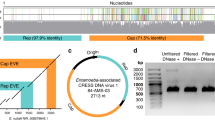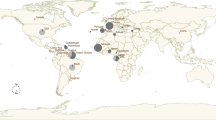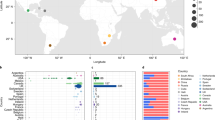Abstract
Human cryptosporidiosis is the leading protozoan cause of diarrhoeal mortality worldwide, and a preponderance of infections is caused by Cryptosporidium hominis and C. parvum. Both species consist of several subtypes with distinct geographical distributions and host preferences (that is, generalist zoonotic and specialist anthroponotic subtypes). The evolutionary processes that drive the adaptation to the human host and the population structures of Cryptosporidium remain unknown. In this study, we analyse 21 whole-genome sequences to elucidate the evolution of anthroponosis. We show that Cryptosporidium parvum splits into two subclades and that the specialist anthroponotic subtype IIc-a shares a subset of loci with C. hominis that is undergoing rapid convergent evolution driven by positive selection. C. parvum subtype IIc-a also has an elevated level of insertion and deletion mutations in the peri-telomeric genes, which is also a characteristic of other specialist subtypes. Genetic exchange between Cryptosporidium subtypes plays a prominent role throughout the evolution of the genus. Interestingly, recombinant regions are enriched for positively selected genes and potential virulence factors, which indicates adaptive introgression. Analysis of 467 gp60 sequences collected from locations across the world shows that the population genetic structure differs markedly between the main zoonotic subtype (isolation-by-distance) and the anthroponotic subtype (admixed population structure). We also show that introgression between the four anthroponotic Cryptosporidium subtypes and species included in this study has occurred recently, probably within the past millennium.
This is a preview of subscription content, access via your institution
Access options
Access Nature and 54 other Nature Portfolio journals
Get Nature+, our best-value online-access subscription
$29.99 / 30 days
cancel any time
Subscribe to this journal
Receive 12 digital issues and online access to articles
$119.00 per year
only $9.92 per issue
Buy this article
- Purchase on Springer Link
- Instant access to full article PDF
Prices may be subject to local taxes which are calculated during checkout




Similar content being viewed by others
Data availability
All WGS data used in this paper are available publically and for free via the NCBI server (https://www.ncbi.nlm.nih.gov/) or CryptoDB (http://cryptodb.org/cryptodb/). The accession codes for the data are provided in Supplementary Table 1.
References
Liu, L. et al. Global, regional, and national causes of child mortality: an updated systematic analysis for 2010 with time trends since 2000. Lancet 379, 2151–2161 (2012).
Kotloff, K. L. et al. Burden and aetiology of diarrhoeal disease in infants and young children in developing countries (the Global Enteric Multicenter Study, GEMS): a prospective, case–control study. Lancet 382, 209–222 (2013).
Widmer, G. & Sullivan, S. Genomics and population biology of Cryptosporidium species. Parasite Immunol. 34, 61–71 (2012).
Mazurie, A. et al. Comparative genomics of Cryptosporidium. Int. J. Genom. 2013, 832756 (2013).
Bushell, E. et al. Functional profiling of a Plasmodium genome reveals an abundance of essential genes. Cell 170, 260–272 (2017).
McMullan, M. et al. Evidence for suppression of immunity as a driver for genomic introgressions and host range expansion in races of Albugo candida, a generalist parasite. eLife 4, e04550 (2015).
Jouet, A. et al. Albugo candida race diversity, ploidy and host‐associated microbes revealed using DNA sequence capture on diseased plants in the field. New Phytol. 221, 1529–1543 (2018).
Lorenzi, H. et al. Local admixture of amplified and diversified secreted pathogenesis determinants shapes mosaic Toxoplasma gondii genomes. Nat. Commun. 7, 10147 (2016).
Abrahamsen, M. S. et al. Complete genome sequence of the apicomplexan, Cryptosporidium parvum. Science 304, 441–445 (2004).
Xu, P. et al. The genome of Cryptosporidium hominis. Nature 431, 1107–1112 (2004).
Bouzid, M., Hunter, P. R., Chalmers, R. M. & Tyler, K. M. Cryptosporidium pathogenicity and virulence. Clin. Microbiol. Rev. 26, 115–134 (2013).
Widmer, G. et al. Comparative genome analysis of two Cryptosporidium parvum isolates with different host range. Infect. Genet. Evol. 12, 1213–1221 (2012).
Guo, Y. et al. Comparative genomic analysis reveals occurrence of genetic recombination in virulent Cryptosporidium hominis subtypes and telomeric gene duplications in Cryptosporidium parvum. BMC Genom. 16, 320 (2015).
Li, N. et al. Genetic recombination and Cryptosporidium hominis virulent subtype IbA10G2. Emerg. Infect. Dis. 19, 1573–1582 (2013).
Xiao, L. & Ryan, U. M. Cryptosporidiosis: an update in molecular epidemiology. Curr. Opin. Infect. Dis. 17, 483–490 (2004).
Puleston, R. L. et al. The first recorded outbreak of cryptosporidiosis due to Cryptosporidium cuniculus (formerly rabbit genotype), following a water quality incident. J. Water Health 12, 41–50 (2014).
Koehler, A. V., Whipp, M. J., Haydon, S. R. & Gasser, R. B. Cryptosporidium cuniculus—new records in human and kangaroo in Australia. Parasit. Vectors 7, 492 (2014).
Wang, Y. et al. Population genetics of Cryptosporidium meleagridis in humans and birds: evidence for cross-species transmission. Int. J. Parasitol. 44, 515–521 (2014).
Koehler, A. V. et al. Cryptosporidium viatorum from the native Australian swamp rat Rattus lutreolus—an emerging zoonotic pathogen? Int. J. Parasitol. Parasites Wildl. 7, 18–26 (2018).
Li, N. et al. Subtyping Cryptosporidium ubiquitum, a zoonotic pathogen emerging in humans. Emerg. Infect. Dis. 20, 217–224 (2014).
Joachim, A. Human cryptosporidiosis: an update with special emphasis on the situation in Europe. J. Vet. Med. B Infect. Dis. Vet. Publ. Health 51, 251–259 (2004).
Chappell, C. L. et al. Cryptosporidium muris: infectivity and illness in healthy adult volunteers. Am. J. Trop. Med. Hyg. 92, 50–55 (2015).
Martin, S. H. & Van Belleghem, S. M. Exploring evolutionary relationships across the genome using topology weighting. Genetics 206, 429–438 (2017).
Okhuysen, P. C. et al. Infectivity of a Cryptosporidium parvum isolate of cervine origin for healthy adults and interferon-γ knockout mice. J. Infect. Dis. 185, 1320–1325 (2002).
Chappell, C. L. et al. Cryptosporidium meleagridis: infectivity in healthy adult volunteers. Am. J. Trop. Med. Hyg. 85, 238–242 (2011).
Santín, M., Trout, J. M. & Fayer, R. A longitudinal study of cryptosporidiosis in dairy cattle from birth to 2 years of age. Vet. Parasitol. 155, 15–23 (2008).
Current, W. L. Cryptosporidiosis. J. Am. Vet. Med. Assoc. 187, 1334–1338 (1985).
Animal Transport Guides: Transport of Calves (The European Commission, 2017); http://animaltransportguides.eu/
Welfare of Animals During Transport PB 12544a (Defra Publications, 2011).
Ares, E. & Ward, M. Live Animal Exports Briefing No. 8031 (Commons Library, 2017).
Travel Trends: 2016 (Office for National Statistics, 2017); https://www.ons.gov.uk/peoplepopulationandcommunity/leisureandtourism/articles/traveltrends/2016
Jelinek, T. et al. Prevalence of infection with Cryptosporidium parvum and Cyclospora cayetanensis among international travellers. Gut 41, 801–804 (1997).
Nair, P. et al. Epidemiology of cryptosporidiosis in North American travelers to Mexico. Am. J. Trop. Med. Hyg. 79, 210–214 (2008).
Chalmers, R. M. et al. Geographic linkage and variation in Cryptosporidium hominis. Emerg. Infect. Dis. 14, 496–498 (2008).
Sundararaman, S. A. et al. Genomes of cryptic chimpanzee Plasmodium species reveal key evolutionary events leading to human malaria. Nat. Commun. 7, 11078 (2016).
Rutledge, G. G. et al. Plasmodium malariae and P. ovale genomes provide insights into malaria parasite evolution. Nature 542, 101–104 (2017).
King, K. C., Stelkens, R. B., Webster, J. P., Smith, D. F. & Brockhurst, M. A. Hybridization in parasites: consequences for adaptive evolution, pathogenesis, and public health in a changing world. PLoS Pathog. 11, e1005098 (2015).
Akiyoshi, D. E., Mor, S. & Tzipori, S. Rapid displacement of Cryptosporidium parvum type 1 by type 2 in mixed infections in piglets. Infect. Immun. 71, 5765–5771 (2003).
Grinberg, A. & Widmer, G. Cryptosporidium within-host genetic diversity: systematic bibliographical search and narrative overview. Int. J. Parasitol. 46, 465–471 (2016).
Puiu, D. et al. CryptoDB: the Cryptosporidium genome resource. Nucleic Acids Res. 32, D329–D331 (2004).
Hadfield, S. J. et al. Generation of whole genome sequences of new Cryptosporidium hominis and Cryptosporidium parvum isolates directly from stool samples. BMC Genom. 16, 650 (2015).
Wang, D., Zhang, Y., Zhang, Z., Zhu, J. & Yu, J. KaKs_Calculator 2.0: a toolkit incorporating gamma-series methods and sliding window strategies. Genom. Proteom. Bioinform. 8, 77–80 (2010).
Hall, T. A. BioEdit: a user-friendly biological sequence alignment editor and analysis program for Windows 95/98/NT. Nucleic Acids Symp. Ser. 41, 95–98 (1999).
Wheeler, D. L. et al. Database resources of the national center for biotechnology. Nucleic Acids Res. 31, 28–33 (2003).
Rice, P., Longden, I. & Bleasby, A. EMBOSS: the European molecular biology open software suite. Trends Genet. 16, 276–277 (2000).
Sayers, E. W. Database resources of the national center for biotechnology information. Nucleic Acids Res. 38, D5–D16 (2010).
Kumar, S., Stecher, G. & Tamura, K. MEGA7: molecular evolutionary genetics analysis version 7.0 for bigger datasets. Mol. Biol. Evol. 33, 1870–1874 (2016).
Apweiler, R. et al. UniProt: the universal protein knowledgebase. Nucleic Acids Res. 32, D115–D119 (2004).
Horton, P. et al. WoLF PSORT: protein localization predictor. Nucleic Acids Res. 35, W585–W587 (2007).
Suyama, M., Torrents, D. & Bork, P. PAL2NAL: robust conversion of protein sequence alignments into the corresponding codon alignments. Nucleic Acids Res. 34, W609–W612 (2006).
Librado, P. & Rozas, J. DnaSP v5: a software for comprehensive analysis of DNA polymorphism data. Bioinformatics 25, 1451–1452 (2009).
Bolger, A. M., Lohse, M. & Usadel, B. Trimmomatic: a flexible trimmer for Illumina sequence data. Bioinformatics 30, 2114–2120 (2014).
Langmead, B. & Salzberg, S. L. Fast gapped-read alignment with Bowtie 2. Nat. Methods 9, 357–359 (2012).
Walker, B. J. et al. Pilon: an integrated tool for comprehensive microbial variant detection and genome assembly improvement. PLoS ONE 9, e112963 (2014).
Martin, D. P., Murrell, B., Golden, M., Khoosal, A. & Muhire, B. RDP4: detection and analysis of recombination patterns in virus genomes. Virus Evol. 1, vev003 (2015).
Li, H. et al. The sequence alignment/map format and SAMtools. Bioinformatics 25, 2078–2079 (2009).
Li, H. A statistical framework for SNP calling, mutation discovery, association mapping and population genetical parameter estimation from sequencing data. Bioinformatics 27, 2987–2993 (2011).
Zheng, X. et al. A high-performance computing toolset for relatedness and principal component analysis of SNP data. Bioinformatics 28, 3326–3328 (2012).
Stamatakis, A. RAxML version 8: a tool for phylogenetic analysis and post-analysis of large phylogenies. Bioinformatics 30, 1312–1313 (2014).
Leaché, A. D. et al. Short tree, long tree, right tree, wrong tree: new acquisition bias corrections for inferring SNP phylogenies. Syst. Biol. 64, 1032–1047 (2015).
Paradis, E., Claude, J. & Strimmer, K. APE: analyses of phylogenetics and evolution in R language. Bioinformatics 20, 289–290 (2004).
Bouckaert & R. R. & Heled, J. DensiTree 2 (Univ. Auckland, 2014); https://www.cs.auckland.ac.nz/~remco/DensiTree/download.html
Ward, B. J. & van Oosterhout, C. HYBRIDCHECK: software for the rapid detection, visualization and dating of recombinant regions in genome sequence data. Mol. Ecol. Resour. 16, 534–539 (2016).
Lynch, M. et al. Genetic drift, selection and the evolution of the mutation rate. Nat. Rev. Genet. 17, 704–714 (2016).
Beghain, J. et al. Plasmodium copy number variation scan: gene copy numbers evaluation in haploid genomes. Malar. J. 15, 206 (2016).
West, S. A., Smith, T. G. & Read, A. F. Sex allocation and population structure in apicomplexan (protozoa) parasites. Proc. R. Soc. Lond. B 267, 257–263 (2000).
Chauve, C. M., Reynaud, M. C. & Gounel, J. M. Description d’Eimeria mulardi N. sp. chez le canard mulard. Etude de la phase endogene de son cycle evolutif avec mise en evidence du developpement intranucleaire. Parasite 1, 15–22 (1994).
Omata, Y. et al. Isolation of coccidian enteroepithelial stages of Toxoplasma gondii from the intestinal mucosa of cats by Percoll density-gradient centrifugation. Parasitol. Res. 83, 574–577 (1997).
Ridley, R. K. & Olsen, R. M. Rapid diagnosis of bovine cryptosporidiosis with a modified commercial acid-fast staining procedure. J. Vet. Diagn. Invest. 3, 182–183 (1991).
Kosek, M., Alcantara, C., Lima, A. A. M. & Guerrant, R. L. Cryptosporidiosis: an update. Lancet Infect. Dis. 1, 262–269 (2001).
O’Hara, S. P. & Chen, X. M. The cell biology of Cryptosporidium infection. Microb. Infect. 13, 721–730 (2011).
Upton, S. J. Basic Biology of Cryptosporidium (Division of Biology, Kansas State University, 2008).
Fleming, R. Cryptosporidium: Could It Be in Your Water? (Ontario Ministry of Agriculture, Food and Rural Affairs, 2015).
Current, W. L. & Haynes, T. B. Complete development of Cryptosporidium in cell culture. Science 224, 603–605 (1984).
Benson, D. A. et al. GenBank. Nucleic Acids Res. 41, D36–D42 (2013).
Bandelt, H. J., Forster, P. & Röhl, A. Median-joining networks for inferring intraspecific phylogenies. Mol. Biol. Evol. 16, 37–48 (1999).
R Core Team R: A Language and Environment for Statistical Computing (R Foundation for Statistical Computing, 2013); http://www.R-project.org/.
Acknowledgements
This work was supported by funds awarded to K.M.T. and R.M.C. from the FP7-KBBE EU project AQUAVALENS, grant agreement 311846 from the European Union was awarded to P.R.H. and a Biotechnology and Biological Sciences Research Council grant (BB/N02317X/1) awarded to C.v.O., as well as support from the Earth & Life Systems Alliance. P.R.H. is supported by the National Institute for Health Research Health Protection Research Unit in Gastrointestinal Infections at the University of Liverpool, in partnership with Public Health England and in collaboration with University of East Anglia, University of Oxford and the Institute of Food Research. P.R.H. is based at the University of East Anglia. The views expressed are those of the authors and not necessarily those of the National Health Service, the National Institute for Health Research, the Department of Health or Public Health England. J.A.P. and M.T.S. were supported by funding from the Knowledge Economy Skills Scholarships and received strategic funding from the Biotechnology and Biological Sciences Research Council. We thank G. Pérez-Cordón for VNTR validation of isolates.
Author contributions
K.M.T., R.M.C., P.R.H., J.L.N. and C.v.O. conceived the study. J.L.N. and C.v.O. designed the analyses. J.L.N., J.A.P., G.R., M.T.S., P.R.H., K.M.T. and R.M.C. were involved in the acquisition of data. J.L.N. conducted the meta-analysis. J.L.N. and C.v.O. conducted the evolutionary genetic analyses with input from T.C.M. for the phylogenetic analysis and B.J.W. for the recombinant analyses. J.L.N., T.C.M and C.v.O. drafted the submitted manuscript. All authors contributed to revising the draft, had full access to all the data and read and approved the final manuscript.
Author information
Authors and Affiliations
Corresponding authors
Ethics declarations
Competing interests
The authors declare no competing interests.
Additional information
Publisher’s note: Springer Nature remains neutral with regard to jurisdictional claims in published maps and institutional affiliations.
Supplementary information
Supplementary Information
Supplementary Tables 1–10 Supplementary Figures 1–9 and Supplementary References.
Supplementary Dataset 1
Supplementary References for systematic review.
Rights and permissions
About this article
Cite this article
Nader, J.L., Mathers, T.C., Ward, B.J. et al. Evolutionary genomics of anthroponosis in Cryptosporidium. Nat Microbiol 4, 826–836 (2019). https://doi.org/10.1038/s41564-019-0377-x
Received:
Accepted:
Published:
Issue Date:
DOI: https://doi.org/10.1038/s41564-019-0377-x
This article is cited by
-
Cryptosporidium Genomics — Current Understanding, Advances, and Applications
Current Tropical Medicine Reports (2024)
-
Cryptosporidium mortiferum n. sp. (Apicomplexa: Cryptosporidiidae), the species causing lethal cryptosporidiosis in Eurasian red squirrels (Sciurus vulgaris)
Parasites & Vectors (2023)
-
Cryptosporidium parvum gp60 subtypes in diarrheic lambs and goat kids from Israel
Parasitology Research (2023)
-
Construction of a recombinant food-grade Lactococcus lactis expressing P23 protein of Cryptosporidium parvum
Folia Microbiologica (2022)
-
An update on Cryptosporidium biology and therapeutic avenues
Journal of Parasitic Diseases (2022)



